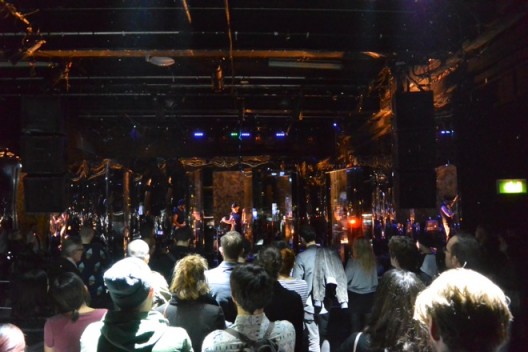Zhang Ding “Enter the Dragon”
ICA London (The Mall, London), Oct 12–25, 2015
Soundwaves pumped through as I entered a darkened chamber, disoriented and anxious. Lights pulsed and music electrified. A crowd stood transfixed by the vision and noise as DJs on opposing stages took turns or together programming sound. The audience in the pit between the stages turned in sync with each new improvised set. Separating DJs and audience: two banks of four mirrored walls—tall and faceted—spun at vertiginous speed, oscillating with the beat. The disco ball has become a threshing machine.
Fear and Ecstasy
Neither angels nor aliens, these bewitching monoliths have landed from a galaxy deep in the subconscious; magic mirrors reflecting the hope and fear, narcissism and morbidity at the heart of the eternal existential paradox: we are unhinged by desire but petrified of reality.
Evening had fallen as I emerged from the ICA into the pensive stillness of the Mall, London’s royal parade road running between Buckingham Palace and Trafalgar Square. Decorated with British and Chinese flags in preparation for Xi Jinping’s state visit the following week, the avenue was almost empty. “Enter the Dragon” is titled after Bruce Lee’s 1973 film, directed by Robert Clouse. On one level, Zhang Ding’s installation speaks to the strange East-West hysteria of celebration and anxiety regarding the other (not incidentally, the other major Chinese exhibition in London was Ai Weiwei at the Royal Academy). It is a red herring. Bruce Lee died of a misadventure: an allergic reaction to a painkiller.
Fear and hope have been at the heart of Zhang Ding’s work from the beginning. “Tools–2” (2007) presented a cactus that was slowly watered to death. The 2-channel film “Boxing” (2007) involved the artist hitting a cactus punching bag. “Law” (2009) had a precarious platform which visitors had to climb in order to peer into a pit of shining light bulbs. Delusion and entertainment were themes in the film “Great Era” (2007), about a migrant worker. More recently, the ballroom dancers of “Buddha Jumps over the Wall” (2012) and punk rock concert of “Orbit of Rock” (2014)—a homage to the legendary 1991 “Monsters of Rock” concert in Moscow—set up a strange opposition of performance and entertainment, which in life we all engage in. Even in front of a television, we are never completely passive receivers of “entertainment” but processors and participants in its consumption. People in the audience are not just receptors but accessories, adaptors and relay stations. We dance for release from the everyday but also to be seen dancing. We scream at the concert to be herd with the crowd. A singer without a crowd is not a performer. He is just a lonely singer. These themes fold one over the other in “Enter the Dragon”.
Behind the DJs hung tall golden foam panels—ritual architectural adornments; matter filled with air but with a façade of density and depth; they were untouchable sound absorbers glimpsed through the whirring reflectors. The mirrors and foam are doubles for people themselves and our habits of public presentation and defense. They disconcert precisely because they represent us. This is not entertainment—not for us. We are being processed. Hope and delusion stand together, mesmerized by the shining blades of furious mirrors; tricked by a promise we made ourselves. Fear is ecstatic. Which pill do you take?

张鼎《龙争虎斗》展览现场,伦敦当代艺术中心

张鼎《龙争虎斗》展览现场,伦敦当代艺术中心

张鼎《龙争虎斗》展览现场,伦敦当代艺术中心


张鼎《龙争虎斗》展览现场,伦敦当代艺术中心

张鼎《龙争虎斗》展览现场,伦敦当代艺术中心